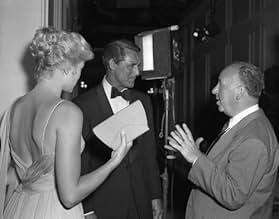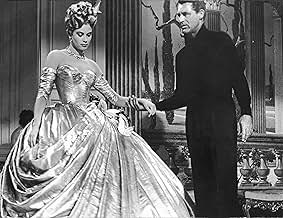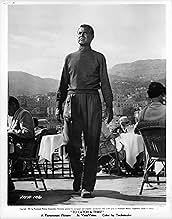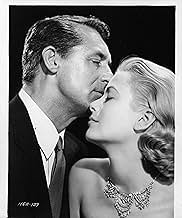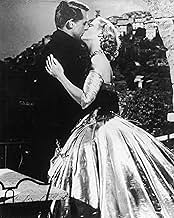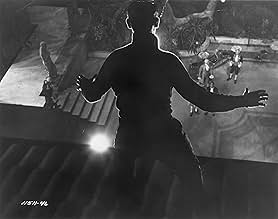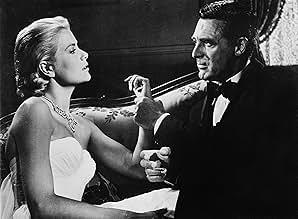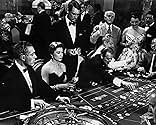Un voleur de bijoux à la retraite cherche à prouver son innocence après avoir été soupçonné de vol.Un voleur de bijoux à la retraite cherche à prouver son innocence après avoir été soupçonné de vol.Un voleur de bijoux à la retraite cherche à prouver son innocence après avoir été soupçonné de vol.
- Director
- Writers
- Stars
- A remporté 1 oscar
- 1 victoire et 5 nominations au total
George Adrian
- Detective
- (uncredited)
John Alderson
- Detective at the Costume Ball
- (uncredited)
Martha Bamattre
- Kitchen Helper
- (uncredited)
René Blancard
- Commissaire Lepic
- (uncredited)
Eugene Borden
- French Waiter
- (uncredited)
Nina Borget
- Frenchwoman
- (uncredited)
George Boyce
- Party Guest
- (uncredited)
John Breen
- Party Guest
- (uncredited)
Margaret Brewster
- Cold-cream Woman
- (uncredited)
Ralph Brooks
- Casino Patron
- (uncredited)
Sommaire
Reviewers say 'To Catch a Thief' is celebrated for its cinematography, vibrant colors, and picturesque French Riviera locations. Cary Grant and Grace Kelly's chemistry and performances are highly praised. However, some find the plot less engaging and the suspense lacking compared to other Hitchcock films. The lighter tone and romantic elements receive mixed opinions, while the beautiful costumes and set designs are standout features.
Avis en vedette
A bit of a departure for Alfred Hitchcock, somewhat lighter and with less of the trademark suspense. Thoroughly enjoyable, though. Cary Grant was playing Cary Grant by this time, and no one could do it better. And Grace Kelly, what eye-candy! The snappy dialog with the sexual innuendo was done perfectly. And huge kudos to Brigitte Auber, who was gorgeous and very good. An interesting aside was that Grant's character, while pretending to be someone else, claimed to have been an American circus acrobat, which Grant sort of was early in life (albeit English, not American.) Grant (with his accent) could really never be mistaken for an American, even though he usually played one. Also it was a little eerie to see Grace Kelly driving so fast on those French Riviera cliffside roads, in light of what happened to her later. (Of course, she obviously wasn't doing so, they were using back-projection) Anyway, this film is a must for fans of Hitchcock, Kelly or Grant. Grade: A
This film, "disappointing"? Who is that reviewer kidding? No female would ever say that. This film is escapism at its finest, and what, pray tell, is wrong with escapism in this ever-more-dreary and stressful world? I don't CARE that this isn't a serious acting effort on Cary Grant's behalf; I don't CARE that the plot is telescoped. What I DO care about is the fantasy of it all: the beauty of the two stars, their clothing, the surroundings, the sets, and the way this movie just takes a (female) viewer away to a place and time that she will never have experienced but would love to experience: the South of France in the '50s; healthy, witty people with unlimited funds; sunshine, flowers, villas; amusing intrigue involving stolen jewels; the sparkle of the Mediterranean. And that gaspingly gorgeous costume ball! Wow! Please. This is a frothy and fabulous dreamscape like no other. After a very stressful day, to lie down with a glass of chilled champagne and watch Cary Grant and Grace Kelly cavort on the French Riviera is the most sublime thing one could do. I know more than a few females who honestly could not have withstood their lives without the escape this film provides. Thank you Mr. Hitchcock! You have performed a great, great service!
There is much to like about Hitchcock's TO CATCH A THIEF: Cary Grant and Grace Kelly at the height of their appeal, a witty script that offers Jessie Royce Landis one of the funniest roles ever seen in any Hitchcock film, and excellent cinematography designed to show off the beauties of Monte Carlo--all packaged in a lightweight tale that is two parts romance, two parts travelogue, one part comedy, and just enough classic Hitchcock suspense to keep this lighter-than-air confection from flying apart.
The well known story concerns a string of jewel robberies along the Riviera which lead local officials to suspect that a famous and long retired cat burglar (Grant) is once more on the prowl--but rather than hope the authorities will find the real culprit Grant elects to protect himself by unmasking the thief for himself. In the process he encounters an icy beauty (Kelly) who takes considerable pleasure in tantalizing him with her charms, her jewels, and her knowledge of his criminal past, and her mother (Landis), who is perhaps the best of the "clever matrons" to appear in any Hitchcock film. As the police close in, the three of them devise a plot to expose the thief and clear Grant, with whom Kelly has now fallen in love.
Unlike most Hitchcock's most famous films, TO CATCH A THIEF offers nothing dark to trouble our thoughts, and it is perhaps best regarded as a romantic fantasia, the director's vacation from his more typical material. While it will never compete with the more famous VERTIGO and REAR WINDOW of the same period, it is extremely well done and quite a bit of fun to watch. Viewers seeking a pleasant film with a romantic touch will enjoy it a great deal.
Gary F. Taylor, aka GFT, Amazon Reviewer
The well known story concerns a string of jewel robberies along the Riviera which lead local officials to suspect that a famous and long retired cat burglar (Grant) is once more on the prowl--but rather than hope the authorities will find the real culprit Grant elects to protect himself by unmasking the thief for himself. In the process he encounters an icy beauty (Kelly) who takes considerable pleasure in tantalizing him with her charms, her jewels, and her knowledge of his criminal past, and her mother (Landis), who is perhaps the best of the "clever matrons" to appear in any Hitchcock film. As the police close in, the three of them devise a plot to expose the thief and clear Grant, with whom Kelly has now fallen in love.
Unlike most Hitchcock's most famous films, TO CATCH A THIEF offers nothing dark to trouble our thoughts, and it is perhaps best regarded as a romantic fantasia, the director's vacation from his more typical material. While it will never compete with the more famous VERTIGO and REAR WINDOW of the same period, it is extremely well done and quite a bit of fun to watch. Viewers seeking a pleasant film with a romantic touch will enjoy it a great deal.
Gary F. Taylor, aka GFT, Amazon Reviewer
This is probably Hitchcock's most beautiful movie. Grace Kelly is well (but of course decorously) displayed in delicate and perfectly fitted summer dresses and evening gowns (designed by Edith Head) that show off her exquisite arms and shoulders while accentuating her elegant neck and jaw line--and, as she turns for the camera, the graceful line of her back. Opposite her is one of Hollywood's most dashing leading men, the incomparable Cary Grant.
The cinematography by long-time Hitchcock collaborator Robert Burks was shot on location in the French Riviera. The style is daylight clear and sparkling, bright as the dream of a princess to be, always focused without a hint of darkness anywhere. Even the scenes shot at night on the rooftops seem to glow. The houses on the hills overlooking Princess Grace's future home and the narrow cobble stone roads with the low-lying stone walls suggest a refined and elegant lifestyle to come. Even though she drives too fast, one is not worried that she might crash...
Cary Grant is John Robie who fought with the French resistance during WWII and then became a jewel thief, dubbed "The Cat" for his ability to slink quietly in the night over roof tops and to steal into the bedrooms of the rich and take their jewels without waking them. As the movie opens he is retired from his life of crime and living comfortably in a villa in the hills above Nice. The complications begin immediately as the police arrive at his villa to question him about some recent cat-like jewel robberies. Robie is innocent of course (we are led to believe) and to prove his innocence he is motivated to find the real thief.
Grace Kelly plays Frances Stevens, the slightly naughty nouveau riche daughter of the widow of a Texas-style oil millionaire. She is used to having men fall all over themselves trying to court her, but Robie seems uninterested, and this excites her fancy and she goes after him. It is interesting to note that by this time Cary Grant (51 when the film was released) had become such a heart throb that directors liked to have the women (who were always noticeably younger; Kelly was 26) chase after him. Audrey Hepburn does as much in Charade (1963). One notes that here, as in Charade, the women kiss Cary Grant first, not the other way around. Here it is nicely done as the previously demure Frances takes a surprising initiative at the door of her hotel suite.
The story itself is rather bland and predictable, reminding me of a James Bond flick from, say, the sixties as though toned down for an audience of old maids. Notable in supporting roles are Brigitte Auber as the athletic Danielle Foussard, John Williams as the British insurance agent, and Jessie Royce Landis as Frances Stevens' mother. Hitch makes his de rigueur appearance as a passenger on the mini-bus that Robie takes to get away from the gendarmes early in the film.
See this for Grace Kelly whose cool and playful demeanor and statuesque beauty form the heart of this somewhat languid romantic thriller.
(Note: Over 500 of my movie reviews are now available in my book "Cut to the Chaise Lounge or I Can't Believe I Swallowed the Remote!" Get it at Amazon!)
The cinematography by long-time Hitchcock collaborator Robert Burks was shot on location in the French Riviera. The style is daylight clear and sparkling, bright as the dream of a princess to be, always focused without a hint of darkness anywhere. Even the scenes shot at night on the rooftops seem to glow. The houses on the hills overlooking Princess Grace's future home and the narrow cobble stone roads with the low-lying stone walls suggest a refined and elegant lifestyle to come. Even though she drives too fast, one is not worried that she might crash...
Cary Grant is John Robie who fought with the French resistance during WWII and then became a jewel thief, dubbed "The Cat" for his ability to slink quietly in the night over roof tops and to steal into the bedrooms of the rich and take their jewels without waking them. As the movie opens he is retired from his life of crime and living comfortably in a villa in the hills above Nice. The complications begin immediately as the police arrive at his villa to question him about some recent cat-like jewel robberies. Robie is innocent of course (we are led to believe) and to prove his innocence he is motivated to find the real thief.
Grace Kelly plays Frances Stevens, the slightly naughty nouveau riche daughter of the widow of a Texas-style oil millionaire. She is used to having men fall all over themselves trying to court her, but Robie seems uninterested, and this excites her fancy and she goes after him. It is interesting to note that by this time Cary Grant (51 when the film was released) had become such a heart throb that directors liked to have the women (who were always noticeably younger; Kelly was 26) chase after him. Audrey Hepburn does as much in Charade (1963). One notes that here, as in Charade, the women kiss Cary Grant first, not the other way around. Here it is nicely done as the previously demure Frances takes a surprising initiative at the door of her hotel suite.
The story itself is rather bland and predictable, reminding me of a James Bond flick from, say, the sixties as though toned down for an audience of old maids. Notable in supporting roles are Brigitte Auber as the athletic Danielle Foussard, John Williams as the British insurance agent, and Jessie Royce Landis as Frances Stevens' mother. Hitch makes his de rigueur appearance as a passenger on the mini-bus that Robie takes to get away from the gendarmes early in the film.
See this for Grace Kelly whose cool and playful demeanor and statuesque beauty form the heart of this somewhat languid romantic thriller.
(Note: Over 500 of my movie reviews are now available in my book "Cut to the Chaise Lounge or I Can't Believe I Swallowed the Remote!" Get it at Amazon!)
The best thing about this film is the chemistry between leads Grant and Kelly. Grant is as debonair as usual and Kelly was never more glamorous. The costumes she wears are very flattering to her and she is to the clothes. The dialogue between them sparkles throughout and is a pleasure to watch even if the course of their relationship is predictable. Grant's self-deprecating in-jokes are another nice touch. Further pleasantly adding to the fantasy ambience is the spectacular photography of the French riviera. John Williams is also great as the insurance investigator, the type of character he played in Hitchcock's Dial M for Murder (also with Kelly) and in the Doris Day-Rex Harrison film, Midnight Lace. This film is not one of the most psychologically involving in Hitchcock's pantheon but it is not designed to be. It is enjoyed best as what it was produced to be: glossy high production value escapist fare. 8/10.
Le saviez-vous
- AnecdotesCary Grant had announced his retirement from acting in February 1953, stating that, since the rise of Method actors like Marlon Brando, most people were no longer interested in seeing him. He was also angry at the way Sir Charles Chaplin had been treated by the HUAC. He was lured out of his retirement to make this movie, and thereafter continued acting for a further eleven years.
- GaffesOn the list of jewelry owners, the room number of Mrs. Jessie Stevens is given as 541, but when John Robie accompanies Mrs. Stevens and her daughter to their rooms, the numbers on their doors are 625 and 623, respectively.
- Citations
Frances Stevens: Mother, the book you're reading is upside down!
- Générique farfeluThe opening title sequence shows the window of a travel agent, with the text of the titles superimposed. The bottom of the window is not quite horizontal because the window is seen from a slight angle to perpendicular. The text of the titles is given slight parallelogram distortion so the bottom line of text is parallel to the window-sill, and therefore it is not horizontal and parallel with the film frame.
- ConnexionsEdited into Histoire(s) du cinéma: Seul le cinéma (1994)
Meilleurs choix
Connectez-vous pour évaluer et surveiller les recommandations personnalisées
Détails
- Date de sortie
- Pays d’origine
- Langues
- Aussi connu sous le nom de
- To Catch a Thief
- Lieux de tournage
- 335 Route de Saint-Jeannet, St Jeannet, France(John Robie's villa)
- société de production
- Consultez plus de crédits d'entreprise sur IMDbPro
Box-office
- Budget
- 2 500 000 $ US (estimation)
- Brut – à l'échelle mondiale
- 7 117 $ US
- Durée1 heure 46 minutes
- Couleur
- Rapport de forme
- 1.85 : 1
Contribuer à cette page
Suggérer une modification ou ajouter du contenu manquant

Lacune principale
By what name was La main au collet (1955) officially released in India in Hindi?
Répondre






